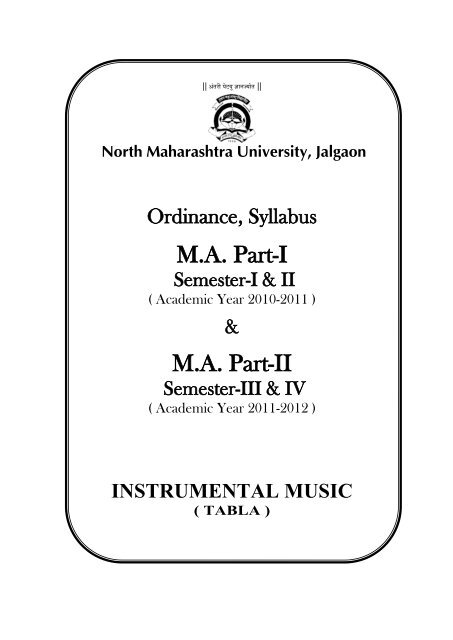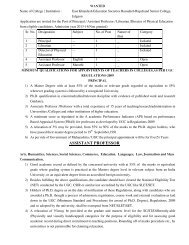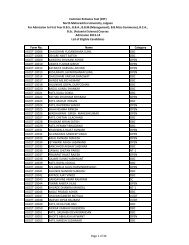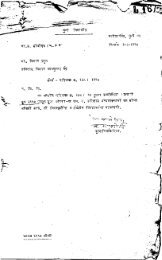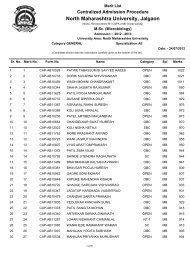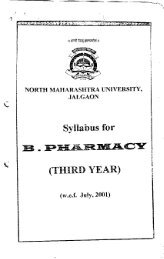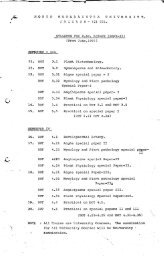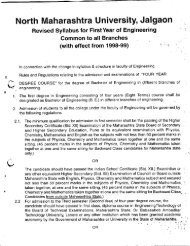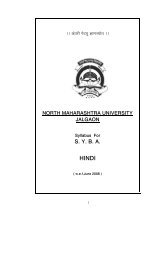M.A. Music-Tabla - North Maharashtra University
M.A. Music-Tabla - North Maharashtra University
M.A. Music-Tabla - North Maharashtra University
Create successful ePaper yourself
Turn your PDF publications into a flip-book with our unique Google optimized e-Paper software.
|| †ÓŸÖ¸üß ¯Öêü¾Öæ –ÖÖÖ•µÖÖêŸÖ ||<br />
<strong>North</strong> <strong>Maharashtra</strong> <strong>University</strong>, Jalgaon<br />
Ordinance, Syllabus<br />
M.A. Part-I<br />
Semester-I & II<br />
( Academic Year 2010-2011 )<br />
&<br />
M.A. Part-II<br />
Semester-III & IV<br />
( Academic Year 2011-2012 )<br />
INSTRUMENTAL MUSIC<br />
( TABLA )<br />
- 0 -
Semester-I<br />
Syllabus of MA-I (Instrumental <strong>Music</strong>) (<strong>Tabla</strong>)<br />
(w.e.f. academic year 2010-11)<br />
Scheme of Examination<br />
MI-101 : PRACTICAL PAPER-STAGE PERFORMANCE (MAJLIS)<br />
MI-102 : PRACTICAL - VIVA<br />
MI-103 : THEORY OF GENERAL APPLIED MUSIC<br />
MI-104 : HISTORY AND THEORY OF MUSIC<br />
Semester-II<br />
MI-201 : PRACTICAL – STAGE PERFORMANCE (MAJLIS)<br />
MI-202 : PRACTICAL – VIVA-VOCE<br />
MI-203 : THEORY OF GENERAL APPLIED MUSIC<br />
MI-204 : HISTORY AND THEORY OF MUSIC<br />
Semester-III<br />
Syllabus of MA-II (Instrumental <strong>Music</strong>) (<strong>Tabla</strong>)<br />
(w.e.f. academic year 2011-12)<br />
MI-301 : PRACTICAL–STAGE PERFORMANCE (MAJLIS)<br />
MI-302 : PRACTICAL – VIVA-VOCE<br />
MI-303 : THEORY OF GENERAL APPLIED MUSIC<br />
MI-304 : HISTORY, AESTHETICS AND PSYCHOLOGY OF INDIAN MUSIC<br />
Semester-IV<br />
MI-401 : PRACTICAL – STAGE PERFORMANCE (MAJLIS)<br />
MI-402 : PRACTICAL – VIVA-VOCE + DISSERTATION<br />
MI-403 : MULTIDIMENSIONAL VALUES, APPLIED AND HISTORICAL<br />
THEORY OF INDIAN MUSIC<br />
MI-404 : RESEARCH METHODOLOGY<br />
- 20 -
Semester-I<br />
MA-I (Instrumental <strong>Music</strong>) (<strong>Tabla</strong>) / Semester-I / Paper-I<br />
MI-101 : PRACTICAL- VIVA & STAGE PERFORMANCE ( MAJLIS )<br />
Paper Title of the Course Final Exam. Internal<br />
Assessment<br />
Total<br />
I Practical-Viva & Stage<br />
Performance<br />
130 20 150<br />
II Practical & Viva 130 20 150<br />
1. Complete <strong>Tabla</strong> Solo in Taala–Ektal & Aada Chaartaal with following<br />
compositions –<br />
Uthan, Peshkar (with five paltas), Kayada (with five paltas), Rela (with<br />
five paltas), Gat, Paran, Tukda, Mukhada, Bant (with five paltas), Gat<br />
Kayada, Tihai (one in each).<br />
2. Practice and knowledge of following compositions in Teentaal (one in<br />
each) –<br />
Stuti Paran, different kinds of Gat, Farmaishee, Kamali.<br />
3. Practice and knowledge of different kinds of compositions in Mishra Jati.<br />
4. Practice and knowledge of basic compositions of Ajrada and Lakhnow<br />
Gharana.<br />
5. Practice and knowledge of following Taalas with Dugun, Tigun and<br />
Chaugun –<br />
Pancham Sawari, Deepchandi, Zumara, Laxmi, Gajzampa.<br />
6. Knowledge of following Taalas –<br />
Teeara, Ganesh, Pashto, Matta Taal, Jaytaal.<br />
7. Perfect tuning of the instrument.<br />
8. Solo performance in Teentaal (about 20 minutes).<br />
300<br />
- 1 -
MA-I (Instrumental <strong>Music</strong>) (<strong>Tabla</strong>) / Semester-I / Paper-II<br />
MI-102 : PRACTICAL & VIVA<br />
1. Practice and knowledge of accompaniment in Vilambit Tilwada of Ektaal<br />
for Khyal Gayaki.<br />
2. Practice and knowledge of accompaniment in Vilambit Addha Taal for<br />
Thumari with Laggi & Tihai.<br />
3. Practice and knowledge of accompaniment for Dhrupad in Taal Teevra<br />
and Chaartaal.<br />
4. Practice and knowledge of Laggi and Ladi in Taal Dadra and Kharawa.<br />
5. Practice and knowledge of accompaniment for Dance with following<br />
compositions –<br />
Stuti Paran, Chakradhar Toda, Amad, Thaats.<br />
6. Recitation (padhant) in all kinds of above matter with Tali and Khali.<br />
7. Knowledge of Duppali, Tippali & Chouppali.<br />
8. Knowledge of Swar.<br />
- 2 -
MA-I (Instrumental <strong>Music</strong>) (<strong>Tabla</strong>) / Semester-I / Paper-III<br />
MI-103 : THEORY OF GENERAL APPLIED MUSIC<br />
Paper Title of the Course Final Exam. Internal<br />
Assessment<br />
Total<br />
III Theory<br />
Applied<br />
<strong>Music</strong><br />
of General 80 20 100<br />
IV History and Theory of<br />
<strong>Music</strong>.<br />
80 20 100<br />
200<br />
1. Definition of the application of the following with examples.<br />
a) Stuti Paran, b) Different types of Gats, c) Farmayashi,<br />
d) Kamali, e) Kriya, f) Jati, g) Yati (five types)<br />
h) Graha (four types)<br />
2. Study and write in notation the following Taalas in Laykari Aad, Kuaad,<br />
Biaad–<br />
Teentaal, Rupak, Zaptal, Ektaal, Chaartaal, Sultaal, Dadra, Kaharwa.<br />
3. Study and writing in notation the following Taalas with Dugun, Tigun,<br />
Chougun Layakaries -<br />
Pancham Sawari, Deepchandi, Zumara, Laxmi, Gajzampa.<br />
4. Writing notation of Ajarada and Lakhnow compositions.<br />
5. Improvisation of Tihai, Mukhada, Tukda in present semester course.<br />
6. Writing in notation of Laggi and Ladi in Taal Dadra and Kaharwa.<br />
7. Writing in notation with following Dance compositions –<br />
a) Stuti Paran, b) Chakradhar Toda, c) Amad.<br />
8. Detailed study of Rela, Bant with different examples.<br />
9. Definitions of Pipilika, Gopucha, Mrudanga, Strotagata.<br />
- 3 -
MA-I (Instrumental <strong>Music</strong>) (<strong>Tabla</strong>) / Semester-I / Paper-IV<br />
MI-104 : HISTORY AND THEORY OF MUSIC<br />
1. Merits and Demerits of Table Player.<br />
2. Study of Karnataka Taala System.<br />
3. Principles of compositing Chakradhar.<br />
4. Classification of <strong>Music</strong>al Instruments.<br />
5. Principles of Taal Rachana.<br />
6. The study of the following percussion instruments –<br />
a) Pakhawaj<br />
b) Dholak<br />
c) Naal<br />
7. Brief history and tradition of different Gharanas.<br />
8. Life sketch and contribution in the field of music of the following artists –<br />
a) Pt. Bhairav Prasad,<br />
b) Ustad Abid Hussain Khan<br />
c) Ustad Gamikhan<br />
d) Ustad Masid Khan<br />
e) Pt. Biru Mishra<br />
f) Ustad Munir Khan<br />
g) Pt. Nana Panse<br />
- 4 -
Semester-II<br />
MA-I (Instrumental <strong>Music</strong>) (<strong>Tabla</strong>) / Semester-II / Paper-I<br />
MI-201 : PRACTICAL-VIVA & STAGE PERFORMANCE<br />
Paper Title of the Course Final Exam. Internal<br />
Assessment<br />
Total<br />
I Practical-Viva & Stage<br />
Performance<br />
130 20 150<br />
II Practical & Viva 130 20 150<br />
1. Practice and knowledge of previous semester course is essential.<br />
2. Complete <strong>Tabla</strong> Solo in Taala – Pancham Sawari with following<br />
compositions (one in each) –<br />
Uthan, Peshkar (with seven paltaas), Kayada (with seven paltaas), Rela<br />
(with seven paltaas), Bant (with seven paltaas), Gat, Gat Kayada, Paran,<br />
Tukda, Mukhda, Tihai (about 20 minutes).<br />
3. Practice and knowledge of following compositions in Teentaal (one in<br />
each) –<br />
Angushthana, Chalan, Gat Paran, different types of Paran.<br />
4. Practice and knowledge of basic compositions of Farukhabad and Punjab<br />
Gharana.<br />
5. Practice & knowledge of following Taalas with Dugun, Tigun, Chougun–<br />
Rudra, Matta and Shesh.<br />
6. Knowledge of following Taalas –<br />
Basant, Shikhar, Jat.<br />
7. Knowledge and study of Sashabdha Kriya and Nishabdha Kriya.<br />
Dhruwa, Shampa, Taal, Sannipat.<br />
Awap, Nishkam, Vikshep, Pravesh.<br />
300<br />
- 5 -
MA-I (Instrumental <strong>Music</strong>) (<strong>Tabla</strong>) / Semester-II / Paper-II<br />
MI-202 : PRACTICAL & VIVA<br />
1. Practice and knowledge of accompaniment in Vilambit Zumara &<br />
Ada Chartaal.<br />
2. Practice and knowledge of accompaniment in Vilambit Deepchandi<br />
for Thumri.<br />
3. Practice and knowledge of accompaniment for Dhrupad in Sultaal<br />
and Dhamar.<br />
4. Practice and knowledge of Laggi and Ladi in Taal Dadra and<br />
Kaharawa.<br />
5. Practice and knowledge of accompaniment for dance with following<br />
compositions (one in each).<br />
Parmelu, Tatkar, Gatnikas.<br />
6. Recitation (padhant) in all kinds of above matter with Tali and<br />
Khali.<br />
7. Practice of playing Teentaal, Rupak, Zaptaal and Ektaal in Drut<br />
Laya.<br />
8. Playing ‘Na Dhin Dhin Na’ in Ati Drut Laya with different Nikas.<br />
- 6 -
MA-I (Instrumental <strong>Music</strong>) (<strong>Tabla</strong>) / Semester-II / Paper-III<br />
MI-203 : THEORY OF GENERAL APPLIED MUSIC<br />
Paper Title of the Course Final Exam. Internal<br />
Assessment<br />
Total<br />
III Theory of General Applied<br />
<strong>Music</strong><br />
80 20 100<br />
IV History and Theory of<br />
<strong>Music</strong><br />
80 20 100<br />
200<br />
1. Definition of the application of the following with examples –<br />
a) Angushtan, b) Chalan, c) Gat Paran, d) Different types of Paran,<br />
e) Lom-Vilom f) Upaj, g) Padhant, h) Prastar Vidhi.<br />
2. Study and writing with in notations the following Taalas in Layakari Aad,<br />
Kuaad & Biaad –<br />
Teentaal, Zaptaal, Rupak, Ektaal, Aada Chartaal, Dhamar, Sultaal, Teevra,<br />
Dadra, Khemta.<br />
3. Study and writing in notations in the following Taalas with Dugun, Tigun,<br />
Chougun, Layakaries –<br />
Rudra, Matta, Tappa, Shesh.<br />
4. Writing in notations of the compositions of Farukhabad and Punjab Gharanas.<br />
5. Improvisation of Tihai, Mukhda, Tukda in Taalas of present and previous<br />
semester course.<br />
6. Writing in notations of Laggi and Ladi in Deepchandi Taala.<br />
7. Writing in notations of compositions of dance in present semester course (one<br />
in each) –<br />
a) Stuti Paran<br />
b) Chakradhar Toda<br />
c) Aamad<br />
8. Detailed study of Gat Kayadas, Uthan, Theka Chalan with different examples.<br />
9. Historical study of one’s own instrument.<br />
10. Definition and descriptive study of Bada Khyal, Chhota Khyal, Thumari,<br />
Tappa, Dhrupad, Dhamar, Bhajan, Hori, Gazal, Kajari.<br />
11. Knowledge and study of Sama, Yati, Laya, Jati, Graha & Anga.<br />
- 7 -
MA-I (Instrumental <strong>Music</strong>) (<strong>Tabla</strong>) / Semester-II / Paper-IV<br />
MI-204 : HISTORY AND THEORY OF MUSIC<br />
1. The similarities and differences between the playing style and techniques<br />
of Pakhwaj and <strong>Tabla</strong>.<br />
2. Comparative study of Khula and Bandh Baaj.<br />
3. Comparative study of Hindustani Taala system and Karnataka Taala<br />
system.<br />
4. Distinguish between Baaj and Gharana.<br />
5. Status of <strong>Tabla</strong> in India percussion instruments.<br />
6. Importance of Laya and Taala in Indian Classical <strong>Music</strong>.<br />
7. Methods of accompaniment of <strong>Tabla</strong> in Semi-Classical <strong>Music</strong>.<br />
8. Western staff notation system.<br />
9. Principles of composing formayashi and Kamali Chakradhar.<br />
10. Concept of Upaj.<br />
11. Life sketch and contribution in the field of music of the following artists –<br />
a) Pt. Anokhelal Mishra, b) Pt. Kanthe Maharaj,<br />
c) Ustad Ahmad Jan Thirakwa, d) Ustad Amir Hussain Khan,<br />
e) Ustad Zahangir Khan, f) Pt. Parvat Singh<br />
12. Brief history of Indian Classical <strong>Music</strong> from the ancient period to modern<br />
period.<br />
- 8 -
SEMESTER - III<br />
MA-II (Instrumental <strong>Music</strong>) (<strong>Tabla</strong>) / Semester-III / Paper-I<br />
MI-301 : PRACTICAL & STAGE PERFORMANCE<br />
Paper Title of the Course Final Exam. Internal<br />
Assessment<br />
Total<br />
I Practical & Stage<br />
Performance<br />
130 20 150<br />
II Practical & Viva 130 20 150<br />
1. Solo performance with advanced and additional matters in any chosen<br />
Taala for about 30 minutes.<br />
2. Solo performance in Taala having 9 or 11 beats for about 15 minutes.<br />
3. Solo demonstration (performance) of different kinds of Laggi and Ladi in<br />
any one of the following Taalas.<br />
a) Dadra<br />
b) Keharawa<br />
c) Deepchandi<br />
d) Chachar<br />
300<br />
- 9 -
MA-II (Instrumental <strong>Music</strong>) (<strong>Tabla</strong>) / Semester-III / Paper-II<br />
MI-302 : PRACTICAL & VIVA<br />
1. Complete <strong>Tabla</strong> Solo in 9 and 11 beats with following compositions.<br />
(one in each) –<br />
Uthan, Peshkar (with ten paltaas and Tihai), Paran, Gat, Kayada (with ten<br />
paltaas and Tihai), Tukda, Mukhda, Tihais, Rela (with ten paltaas and<br />
Tihai).<br />
2. Practice and knowledge of following compositions in Teentaal (one in<br />
each) –<br />
Lahori Gat, Punjabi (Tidhari) Gat, Farmayshi Gat.<br />
3. Advanced compositions of Delhi, Lucknow and Banaras Garana.<br />
4. Practice and knowledge of following Taalas with Dugun, Tigun &<br />
Chougun –<br />
Kumbha, Vishnu, Ganesh.<br />
5. Ability to present a decorative Bharava in following Taalas which is used<br />
for accompaniment in Khayal Gayaki – Ektaal, Teentaal, Zumara,<br />
Tilwada.<br />
6. Ability to present a decorative Bharava in following Taalas used for<br />
accompaniment in Thumari - Jattaal, Addha, Deepchandi.<br />
7. Solo performance with different types of Laggi & Ladi in Dadra and<br />
Keharawa Taalas.<br />
8. Practice and knowledge of accompaniment in Semi-Classical styles like –<br />
Kajri, Dadra, Thumari, Hori, etc.<br />
9. Practice and knowledge of accompaniment for Dance with advanced<br />
compositions.<br />
10. Recitation (Padhant) in all kinds of above matter with Tali and Khali.<br />
11. Practice and knowledge of presenting different types of Layakaries with<br />
Tali and Khali Aad, Kuaad, Biaad and Tigun.<br />
- 10 -
MA-II (Instrumental <strong>Music</strong>) (<strong>Tabla</strong>) / Semester-III / Paper-III<br />
MI-303 : THEORY OF GENERAL APPLIED MUSIC<br />
Paper Title of the Course Final Exam. Internal<br />
Assessment<br />
Total<br />
III Theory of General<br />
Applied <strong>Music</strong><br />
80 20 100<br />
IV History & Theory of<br />
<strong>Music</strong><br />
80 20 100<br />
200<br />
1. Writing notations of all types of compositions of present semester and<br />
previous semester practical course.<br />
2. Ability of composing Tukada, Tihai and Paran in the followings –<br />
a) Teentaal, b) Rupak, c) Zaptaal<br />
3. Ability of composing the Chakradhar in following Taalas –<br />
Teentaal, Rupak, Zaptaal, Aada Chartaal, Pancham Sawari.<br />
4. Ability of composing the Nauhakka Tihai in following Taalas –<br />
Teentaal, Rupak, Zaptaal, Aada Chartaal, Pancham Sawari.<br />
5. Writing notations of Aadi, Kuadi and Biadi laya in the following Taalas –<br />
Teentaal, Rupak, Zaptaal.<br />
6. Ability of composing new Taal, according to Taal Rachana siddhant.<br />
7. Writing notation of present and previous semesters Taalas in Dugun,<br />
Tigun and Chougun.<br />
8. Writing notations of following compositions in Teentaal –<br />
Lahori Gat, Punjabi Gat, Farmayashi Gat.<br />
9. Study of <strong>Music</strong>al Sounds.<br />
10. Formation of Rasa in <strong>Tabla</strong> playing.<br />
11. Creativity in <strong>Tabla</strong> playing.<br />
12. Comparative study of <strong>Tabla</strong> Solo in different Gharanas.<br />
- 11 -
MA-II (Instrumental <strong>Music</strong>) (<strong>Tabla</strong>) / Semester-III / Paper-IV<br />
MI-304 : HISTORY & THEORY OF MUSIC<br />
1. Basic principles of Aesthetics.<br />
2. Study of Aesthetical elements with special reference to <strong>Tabla</strong> –<br />
i) Nikas, ii) Mathematical Aspects, iii) Sam<br />
iv) Padhant, v) Speed, vi) Khali, Bhari<br />
3. Emotional expressions through <strong>Music</strong>.<br />
4. Analysis of artistic presentation of <strong>Tabla</strong>.<br />
5. Definition of Rasa and varieties according to Bharata and Abhinava<br />
Gupta.<br />
6. Ancient principles regarding relationship of music with Rasas – Swar-<br />
Rasa, Laya-Rasa and Chhand-Rasa.<br />
7. The beauty of Vistar (expandable compositions).<br />
8. Brief study of the following –<br />
a) Kal, b) Kala, c) Matra Prastar<br />
9. Brief study of Margi and Deshi Taal.<br />
10. Definition of Chanda in various forms/kinds and utility in <strong>Tabla</strong> playing.<br />
11. Brief life history and contribution to music of the following eminent<br />
artists –<br />
a) Pt. Bhairav Sahai, b) Ustad Allah Rakha,<br />
c) Ustad Inam Ali Khan, d) Shri Purushottam Das Pakhawaji<br />
e) Pt. Khaprumama Parvatkar<br />
- 12 -
Semester-IV<br />
MA-II (Instrumental <strong>Music</strong>) (<strong>Tabla</strong>) / Semester-IV / Paper-I<br />
MI-401 : PRACTICAL - STAGE PERFORMANCE<br />
Paper Title of the Course Final<br />
I Practical & Stage<br />
Performance<br />
II Practical - Viva+<br />
Dissertation<br />
Exam.<br />
Internal<br />
Assessment<br />
130 20<br />
(Intl. Assessment)<br />
100 50<br />
(Dissertation)<br />
Total<br />
1. Solo performance with advanced and additional matter in any chosen<br />
Taala for about 30 minutes.<br />
2. Solo performance in Taala having 13 or 17 beats for about 15 minutes.<br />
3. Solo demonstration (performance) of different kinds of Laggi & Ladi in<br />
any Taala of the syllabus.<br />
150<br />
150<br />
300<br />
- 13 -
MA-II (Instrumental <strong>Music</strong>) (<strong>Tabla</strong>) / Semester-IV / Paper-II<br />
MI-402 : PRACTICAL - VIVA + DISSERTATION<br />
1. Complete <strong>Tabla</strong> solo in Taal having 13 and 17 beats with following<br />
compositions (one in each) –<br />
Uthan, Peshkar (with five paltaas and Tihai), Paran, Gat, Kayada (with<br />
five paltaas and Tihai), Tukada, Mukhada, Tihais, Rela (with five<br />
paltaas).<br />
2. Practice and knowledge of following compositions in Teentaal (one in<br />
each) –<br />
Fard, Charbag Gat, Darjewali Gat.<br />
3. Advanced compositions of Ajarada, Farukhabad and Punjab Gharana.<br />
4. Practice and knowledge of following Taalas with Dugun, Tigun and<br />
Chougun –<br />
Mayur, Shikar, Basant, Ashtamangal, Badi Sawari.<br />
5. Ability to present a decorative Bharava in all Taalas which is used for<br />
accompaniment in Khayal Gayaki.<br />
6. Ability to present a decorative Bharava in all Taalas used for<br />
accompaniment in Thumari.<br />
7. Solo performance with different types of Laggi and Ladi in Kaharawa &<br />
Dadra Taalas.<br />
8. Practice and knowledge of accompaniment for Dance with advanced<br />
compositions.<br />
9. Practice and knowledge of accompaniment in semi-classical styles like –<br />
Tappa, Bhajan, Gazal, Kawwali.<br />
10. Recitation (Padhant) in all kinds of above matter with Tali & Khali.<br />
11. Practice and knowledge of presenting different types of Layakaries with<br />
Tali and Khali Sawai & Poune do gun.<br />
- 14 -
MA-II (Instrumental <strong>Music</strong>) (<strong>Tabla</strong>) / Semester-IV / Paper-III<br />
MI-403 : MULTIDIMENSIONAL VALUES, APPLIED AND HISTORICAL<br />
THEORY OF INDIAN MUSIC<br />
Paper Title of the Course Final Internal Total<br />
Exam. Assessment<br />
III Multidimensional Values, Applied &<br />
Historical Theory of Indian <strong>Music</strong><br />
80 20 100<br />
IV Research Methodology 80 20 100<br />
UNIT-I<br />
1. Detailed study of Taalas Ten Paran.<br />
2. Classification of Indian percussion instruments.<br />
3. Comparative study of traditional and modern aspects in <strong>Tabla</strong> accompaniment.<br />
4. Concept of Taal Vaadya Kachahari.<br />
UNIT-II<br />
1. Brief history of Indian percussion instruments (ancient-modern) –<br />
Mridang, Pakhawaj, Durdhar, Patah, Damaru, Dundambhi, Bheri, Zallari,<br />
Mardul, Dholak, Naal, Tasha, Hudukka, Nagada, Daph.<br />
2. Importance of Indian Rhythmical Instruments in Indian <strong>Music</strong>.<br />
3. Necessity of equal beats of Taalas.<br />
4. Comparative study of different views of the origin of <strong>Tabla</strong>.<br />
UNIT-III<br />
1. Brief history of Western Percussion Instruments –<br />
a) Kettle Drum, b) Tanner Drum, c) Bass & Drum, d) Snaire Draum<br />
2. Concept of Guru-Shishya parampara in Indian Classical <strong>Music</strong>.<br />
3. Brief introduction of popular Ghana Vaadya –<br />
Ghanta, Ghadiyal, Kartal, Zanj, Manjira, Ghungharu, Chimata.<br />
4. Brief life history and contribution to music of the following eminent artists –<br />
a) Ustad Karamatulla Khan, b) Ustad Shekh Daud, c) Pt. Baldeo Sahai,<br />
d) Pt. Molvi Ram, e) Pt. Samata Prasad<br />
UNIT-IV<br />
1. Ability of composing Tukada, Tihai and Paran in present semester Taalas.<br />
2. Writing notations of Aadi, Kuadi & Biadi laya in present and previous semester<br />
Taalas.<br />
3. Ability of composing Farmayshi and Kamali Chakradhar in –<br />
Teentaal, Rupak, Zaptaal, Ektaal, etc.<br />
4. Detailed study of –<br />
a) Nagma (Lahara)<br />
b) Upaj<br />
c) Padhant in <strong>Tabla</strong> Solo.<br />
200<br />
- 15 -
MA-II (Instrumental <strong>Music</strong>) (<strong>Tabla</strong>) / Semester-IV / Paper-IV<br />
MI-404 : RESEARCH METHODOLOGY<br />
Unit-I<br />
1. Research and its definition<br />
2. Varieties of Research<br />
3. Scope & Importance of Research in Indian <strong>Music</strong><br />
Research : Definition, elements of research-scientific approach – research and<br />
communication theories-role-function-scope and importance of communication<br />
research – basic and applied research.<br />
1. Process of research Methodology<br />
2. Selection of Research Topic<br />
3. Methods of Research<br />
Unit-II<br />
Tools of Data Collection : Sources media source books, questionnaire and schedules,<br />
people meter, diary method, field studies, logistic groups, focus groups telephone,<br />
surveys, online polls, random sampling methods and representativeness of the sample,<br />
sampling errors and distribution in the findings.<br />
1. Synopsis<br />
2. Bibliography<br />
3. Questionnaire<br />
4. Index<br />
5. Foot notes<br />
Unit-III<br />
Report Writing : Data analysis techniques – coding and tabulation – non statistical<br />
methods –descriptive – historical – statistical analysis – parametric and non-parametricuni-variety<br />
– bi-variety – multi-variety – tests of significance – levels of measurement –<br />
central tendency – tests of reliability and validity – SPSS and other statistical packages.<br />
Unit-IV<br />
1. Primary and secondary sources for Research in Indian <strong>Music</strong> and their<br />
importance in Research.<br />
2. Manuscripts and books<br />
3. Inscriptions<br />
4. Coins<br />
5. Sculptures, Fescoes, Paintings<br />
6. <strong>Music</strong>al compositions<br />
7. Discs & Tapes.<br />
Media Research as a Tool of Reporting : Readership and/audience surveys,<br />
preparation of research reports/projects/dissertations/theses.<br />
Ethical perspectives of mass media research.<br />
- 16 -
Duration : 2 years<br />
Credits : 100<br />
Credit and Semester System<br />
No. of Seats : 25 (50% seat reservation for backward classes and 30% for ladies as<br />
per Govt. rules)<br />
Minimum Educational Qualifications<br />
This is a two-year full time course. Any student after completion of graduation<br />
in any subject from the <strong>University</strong> Grants Commission, Delhi, approved <strong>University</strong> can<br />
apply for the course with minimum 45% marks at the graduation level. (for Reserved<br />
class Candidates : Pass Class). The candidate has to undergo a mandatory common<br />
entrance test and performance test before the panel of eminent scholars and gurus from<br />
the field of performing arts. This course is not for the beginners.<br />
Candidates who have appeared for their graduate examination can also apply. If<br />
selected they will be admitted only after producing graduate examination passing<br />
certificate. Previous knowledge and training in the respective performing art is<br />
mandatory. All the candidates have to undergo an audition test. All the admissions<br />
given are purely on temporary basis subject to the confirmation from the Office of<br />
Registrar (Eligibility Section), <strong>North</strong> <strong>Maharashtra</strong> <strong>University</strong>.<br />
Tuition and Other Fees<br />
Since this is a self-supporting course, the fee structure is revised from time to<br />
time as per the <strong>University</strong> rules. In addition to this, students have to pay examination<br />
fees per semester. Expenses for hostel accommodation and mess are separate.<br />
Specialization<br />
<strong>Music</strong> : (Hindustani Classical) : Vocal<br />
Instrumental : <strong>Tabla</strong>, Violin, Sitar, Harmonium, Flute, Shehanai<br />
- 17 -
Minimum Mandatory Experience while applying<br />
*<strong>Music</strong> (Vocal):<br />
Candidate should have been trained in at least 10 ragas with the Guru. (For Reserved<br />
Category : should have trained in at least 5 ragas with Guru) and out of which should<br />
be able to sing one Bada and one Chhota Khayal for 20 minutes. (with playing tanpura)<br />
in any three ragas (For Reserved Category : in two ragas) able to sing semi-classical<br />
styles like Thumri, Dadra etc.<br />
*Instrumental:<br />
Percussion-<strong>Tabla</strong>: Candidate should have been trained by the Guru in at least 5<br />
Prachalit Taals and 2 Aprachalit Taals, able to give solo performance in at least three<br />
different Taals for 20 mints. (For Reserved Category : in two Taals).<br />
*String Instruments (e.g. Violin, Sitar, Flute Harmonium) :<br />
Candidate should have been trained in 10 ragas (For Reserved Category : 5 ragas) out<br />
of which able to perform in any three ragas (For Reserved Category : one raga) in<br />
Masitkhani and Razakhani Gat.<br />
- 18 -
M.A. I & II (Instrumental <strong>Music</strong>) (<strong>Tabla</strong>)<br />
Semesters Course Marks /<br />
Int. Asst.<br />
Semester-I<br />
Semester-II<br />
Semester-<br />
III<br />
Semester-<br />
IV<br />
Semesters – I, II, III & IV<br />
MI-101 130 + 20 03 / 01 03<br />
MI-102 130 + 20 02 / 01 02<br />
MI-103 80 + 20 01 / 01 01<br />
MI-104 80 + 20 01 / 01 01<br />
MI-201 130 + 20 03 / 01 03<br />
MI-202 130 + 20 02 / 01 02<br />
MI-203 80 + 20 01 / 01 01<br />
MI-204 80 + 20 01 / 01 01<br />
MI-301 130 + 20 03 / 01 03<br />
MI-302 130 + 20 02 / 01 02<br />
MI-303 80 + 20 01 / 01 01<br />
MI-304 80 + 20 01 / 01 01<br />
MI-401 130 + 20 03 / 01 03<br />
MI-402 100 + 50 02 / 01 02<br />
MI-403 80 + 20 01 / 01 01<br />
MI-404 80 + 20 01 / 01 01<br />
Hours/Week Credit Total 15<br />
Weeks<br />
Notes - i) 25 credits per Semester and 1 credit is allotted to Internal Assessment.<br />
ii) Total 105 credits for all Semesters.<br />
iii) 1 credit = 4 hours.<br />
iv) 15 weeks’ record of credits is given in the above chart.<br />
07<br />
07<br />
07<br />
07<br />
105<br />
105<br />
105<br />
105<br />
- 19 -
|| †ÓŸÖ¸üß ¯Öêü¾Öæ –ÖÖÖ•µÖÖêŸÖ ||<br />
<strong>North</strong> <strong>Maharashtra</strong> <strong>University</strong>, Jalgaon<br />
Ordinance, Syllabus<br />
M.A. Part-II<br />
Semester-III & IV<br />
( Academic Year 2011-2012 )<br />
INSTRUMENTAL MUSIC<br />
( TABLA )<br />
- 21 -


